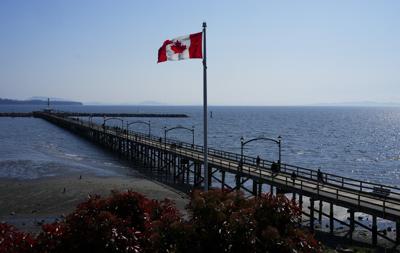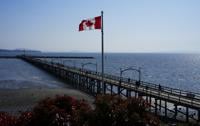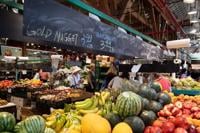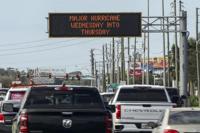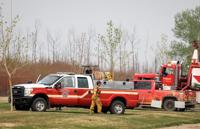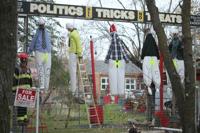For over a year before the November 2024 presidential election, Donald Trump had been signalling plans to impose across-the-board tariffs if he won the United States presidency.
Trump was elected on Nov. 5, and it’s been a roller-coaster ever since for ��ɫtv leaders and businesses. He has threatened, enacted, modified and delayed multiple rounds of tariffs only to announce additional protectionist trade policies are to come.
Here’s a timeline of the key dates in Trump’s tariff journey after he was elected president.
Nov. 25, 2024
Trump pledges to impose a 25 per cent tariff on all ��ɫtv and Mexican imports, saying they would come into force on inauguration day, Jan. 20. He says in a post on Truth Social, a social media site he owns, that the tariffs would remain until both countries stop drugs, particularly fentanyl, and people from illegally crossing American borders.
—�Ĕ�Ĕ
Dec. 11
After ��ɫtv premiers met with then-Prime Minister Justin Trudeau, they confirm the country is preparing retaliatory tariffs in response to Trump’s threat. Securing an exemption or lower levies on energy exports is among the priorities.
—�Ĕ�Ĕ
Jan. 20, 2025
On his inauguration day, Trump says tariffs will likely come on Feb. 1 rather than taking immediate effect.
He also signs an executive order to enact an "America First Trade Policy," calling for his trade and commerce officials to report back to him by April 1 on a sweeping review of U.S. trade policy and relationships.
The date does not come with a default imposition of any tariffs, but does direct Trump's administration to begin examining the Canada-U.S.-Mexico free-trade agreement, which Trump signed in 2018, ahead of a planned 2026 review.
—�Ĕ�Ĕ
Feb. 1
Trump signs an order on Feb. 1 — a Saturday — imposing blanket tariffs of 25 per cent on virtually all goods entering the U.S. from Canada and Mexico, and a reduced 10 per cent tariff on energy, set to take effect Feb. 4.
Trump's Feb. 1 order also imposes 10 per cent tariffs on goods entering the U.S. from China.
Prime Minister Justin Trudeau outlines Canada's planned retaliation strategy, including immediate counter-tariffs that would take effect the same day U.S. tariffs kick in. Over the weekend, ��ɫtv provinces start pulling American alcohol from liquor-store shelves at provincially owned distributors.
—�Ĕ�Ĕ
Feb. 3
Trump pauses the implementation of tariffs on ��ɫtv goods for one month after Ottawa pledges action to secure the border. He does the same for Mexico.
—�Ĕ�Ĕ
Feb. 10
Trump signs a plan to institute 25 per cent tariffs on all steel and aluminum entering the U.S. starting March 12, ending previous exemptions for Canada. Trump previously imposed tariffs on the metals in 2018 but later exempted Canada and Mexico.
—�Ĕ�Ĕ
Feb. 11
Trump says the steel and aluminum tariffs would stack on top of other levies, including the paused 25 per cent tariffs on all ��ɫtv goods other than energy.
—�Ĕ�Ĕ
Feb. 14
Trump had previously threatened to levy tariffs on imported automobiles coming into the U.S. He says on Feb. 14 that tariffs on imported automobiles could come "around April 2," adding the following week that the levies would be "in the neighbourhood of 25 per cent."
Around the same time, he floated imposing similar tariffs on pharmaceuticals and semiconductors, but has yet to provide a timeline for those.
—�Ĕ�Ĕ
Feb. 27
In a Truth Social post, Trump says that April 2 would mark the start of what he terms "reciprocal" tariffs, which would apply to goods coming in from countries that have tariffs or other barriers on U.S. goods.
These would be on top of other tariffs and would match the rates charged by other countries, including subsidies and value-added taxes.
He had signed a memorandum on Feb. 13 directing his trade czar to examine what he perceives as unfair trade practices from other nations.
—�Ĕ�Ĕ
March 4
Trump’s tariffs on ��ɫtv and Mexican goods go ahead after the month-long pause.
There had been hopes that the border security measures Canada took could stave off the tariffs, but on March 3, Trump confirmed they would go ahead, which they did.
Prime Minister Justin Trudeau announced broad retaliatory tariffs on U.S. goods including food, alcohol, furniture, paper and more.
—�Ĕ�Ĕ
March 5
Trump pledges a one-month exemption for vehicles traded under the Canada-U.S.-Mexico Agreement, also known as CUSMA.
White House Press Secretary Karoline Leavitt says during a briefing that the move comes after the Big Three automakers — Stellantis, Ford and General Motors — asked for an exemption.
—�Ĕ�Ĕ
March 6
Dominic LeBlanc, finance minister at the time, says Ottawa will suspend its second wave of retaliatory tariffs after Trump signed an executive order to pause some new duties on Canada and Mexico and reduce potash levies to 10 per cent.
Trump's order links the tariff relief to maintaining the flow of automobile parts that comply with CUSMA and to helping farmers who need potash for fertilizer.
An explanatory statement issued by the White House says there would be no tariffs on goods from Canada and Mexico that claim and qualify for CUSMA preference.
—�Ĕ�Ĕ
March 10
Ontario Premier Doug Ford announces the immediate application of a 25 per cent surcharge on electricity exports to the U.S. as part of the province's retaliation to Trump's tariffs.
Trump responds aggressively, saying he will double the rate on steel and aluminum tariffs set to be implemented March 12 to 50 per cent. He says on Truth Social that the move is in response to Ontario placing a 25 per cent surcharge on electricity it exports to the U.S.
However, Ford agrees to suspend the province's export tax later the same day.
—�Ĕ�Ĕ
March 12
The 25 per cent tariffs on steel and aluminum from all countries take effect.
Canada hits the U.S. with a second tranche of retaliatory tariffs, enacting 25 per cent tariffs on $29.8 billion in U.S. goods, targeting steel and aluminum as well as other products including computers, sports equipment and cast iron goods.
—�Ĕ�Ĕ
March 26
Trump announces 25 per cent sector-specific tariffs on automobile imports, which he says will take effect April 3.
However, the tariffs aren’t across the board. The White House says automobiles imported under CUSMA will only be taxed on the value of content not made in the United States.
As well, vehicle parts under CUSMA will not face Trump's latest duties until Commerce Secretary Howard Lutnick, in consultation with U.S. Customs and Border Protection, "establishes a process to apply tariffs to their non-U. S. content," the White House says.
—�Ĕ�Ĕ
April 2
Trump has called April 2 "Liberation Day."
In a press conference held outside the White House, the president unveiled 10 per cent tariffs on imports from all countries and higher rates on dozens of nations that have trade surpluses with the U.S., including 34 per cent for China and 20 per cent for the European Union.
For Canada and Mexico, however, there was some relief: no new tariffs beyond what has already been announced, and the month-long exemption expected to expire is now indefinite.
Auto tariffs are still expected to come into play on April 3.
Democrat senators plan to force a vote on Trump's use of the emergency powers act to declare an emergency over fentanyl trafficking in order to hit Canada with tariffs. However, even with enough Republican support to pass, it's unlikely to pass the House.
—�Ĕ�Ĕ
April 3
Prime Minister Mark Carney says Canada will hit back against Trump's 25 per cent auto tariffs with matching levies on vehicles imported from the United States.
Carney says Canada's counter-tariffs will hit all vehicles that do not comply with the Canada-U.S.-Mexico Agreement, along with any non-��ɫtv content in compliant vehicles.
That means any vehicles made with less than 75 per cent North American content will face 25 per cent tariffs — a measure that could capture tens of thousands of vehicle imports, according to a background document provided by the Prime Minister's Office.
That could amount to roughly 10 per cent of all cars coming in from the U.S.
Carney says the move could raise as much as $8 billion before any requests for tariff relief are factored in.
All of that money, he said, is to go directly to autoworkers and companies in Canada affected by the burgeoning trade war.
—�Ĕ�Ĕ
April 15
Ottawa says automakers that continue to manufacture vehicles in Canada will see some exemptions from retaliatory tariffs.
��ɫtv manufacturers will be allowed to import a certain number of U.S.-assembled vehicles free of the added charge, imposed in response to U.S. tariffs on ��ɫtv imports.
Ottawa says the number of tariff-free vehicles a company is permitted to import will drop if there are reductions in ��ɫtv production or investment.
—�Ĕ�Ĕ
April 29
Trump signs executive orders giving temporary relief to automakers.
A Commerce Department official says the administration is offering automakers that finish their vehicles in the United States a rebate on imported parts equal to 15 per cent of a vehicle's retail price.
The rebate would drop to 10 per cent the following year.
Companies paying the auto tariffs also won't see some other levies — including ones on steel and aluminum — stacked on top of each other.
—�Ĕ�Ĕ
May 1
U.S. Customs and Border Protection releases guidance that says auto parts compliant with CUSMA won't be hit by tariffs.
The exemption doesn't apply to automobile knock-down kits or parts compilations.
Industry experts had said it would be extremely cumbersome to figure out how to tariff only non-American components of auto parts, which can cross the Canada-U.S. border several times before a vehicle is finished.
—�Ĕ�Ĕ
May 6
Trump and Carney strike a mostly genial tone in their face-to-face meeting in the Oval Office.
But Trump gave no indication he plans to drop tariffs in the near future.
He says while the United States is always going to be friends with Canada, there was nothing Carney could say to convince him to immediately drop tariffs on his northern neighbour.
When asked why, Trump replied that it's "just the way it is."
The president also said he doesn’t want cars, aluminum or steel from Canada.
—�Ĕ�Ĕ
May 28
The U.S. Court of International Trade strikes down Trump's broad-based tariffs on most countries.
The decision blocks both the "Liberation Day" duties as well as tariffs on Canada, Mexico and China ostensibly tied to fentanyl.
A panel of three judges on the New York-based court ruled Trump does not have the authority to impose tariffs on nearly every country using the International Economic Emergency Powers Act.
The Trump administration has filed a notice of appeal and White House officials have condemned the ruling.
— With files from The Associated Press and Kelly Geraldine Malone in Washington
This report by ��ɫtvwas first published May 29, 2025.

